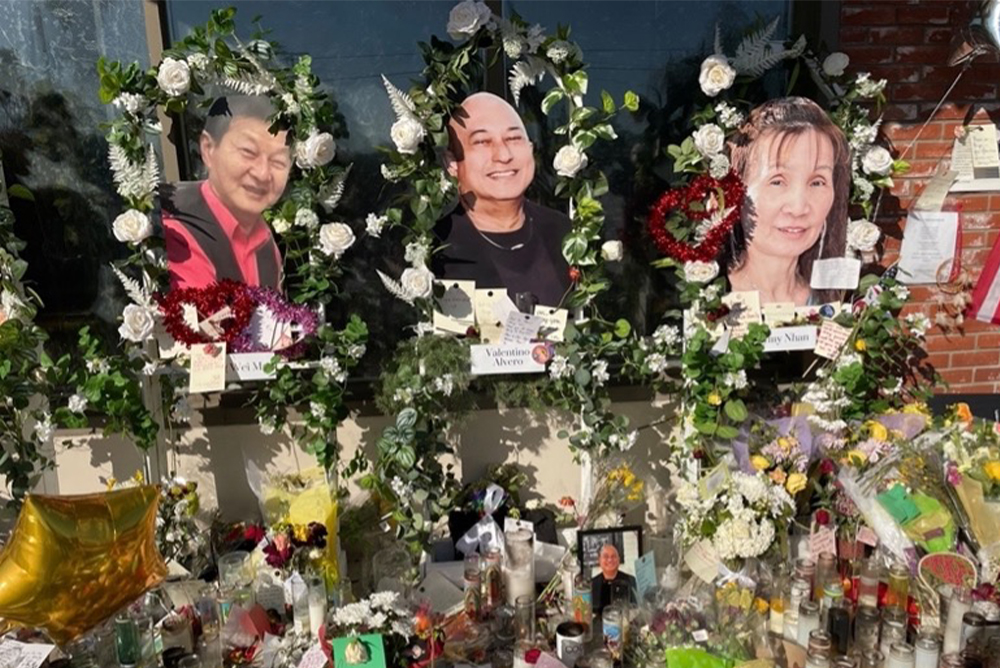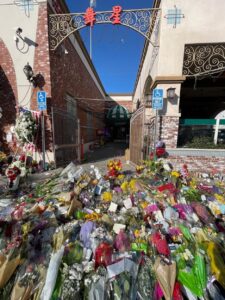
The outpour of community support and solidarity at the public memorial for the victims of the shooting in Monterey Park reflects the deep multiracial and multiethnic history of the city. Geographer Wendy Cheng explains. Photo by author.
On a radiantly sunny afternoon in late January, I visited the parking lot of Star Ballroom Dance Studio in Monterey Park. It had been less than a week since a gunman killed 11 people there ranging in age from 57 to 76, many of them regulars who were there to celebrate Lunar New Year Eve. Eleven altars featuring portraits of the victims had been placed against the brick wall of the studio, along with traditional funeral wreaths draped in white sashes (“Exact Tax Inc.,” “Boys and Girls Club of the West San Gabriel Valley”). Buddhist monks clad in saffron robes chanted sutras in front of a table set with 11 plastic trays of rice and vegetables, and 11 bottles of water: sustenance for each person who died. The earthy-sweet scent of burning incense sticks filled the air. It all momentarily transported me to my grandparents’ funerals in Taiwan, my uncle’s funeral in Arizona. For so many of us with roots in North and Southeast Asia and its diasporas, this is how mourning looks, smells, and feels.
Mounds of flower bouquets, candles, notes, and messages written in chalk adorned the cement in front of the smiling portraits of the victims, along with pyramids of glossy orange tangerines, Asian pears in white Styrofoam netting, and Virgen de Guadalupe candles. “RIP from the 🖤’s of all of us who dance in El Sereno!! It could have been any of us. Rest in Power.” “We Love You – Cal State LA Dance Club.” “Sorry for lost [stet] to your loved ones – Lopez Fam.” “Thoughts and prayers from East LA.” “We are Monterey Park Strong = from the LGBTQ-MPK.” I watched as a young adult wearing a black hoodie crouched, head bowed, in front of one of the memorial altars. After a long moment, they wrote on the asphalt in bright sidewalk chalk: “爸爸, 我愛你.” Dad, I love you.
The people of Monterey Park and its surrounding region had made the parking lot of Star Dance Studio into the public memorial space they needed. These diverse immigrant and ethnic communities don’t wait for permission or for someone else to do it. Instead, they collectively make the space (most often a strip mall parking lot) into what it needs to be, whether that means growing vegetables in a median, making a parking space where none exists, or turning a sidewalk into a marketplace.
In the weeks since the shooting, the media, rightfully, has uplifted Monterey Park as an Asian American hub, a space of possibility for Asian immigrants to make lives and build community. Indeed, it was the first majority Asian city in the continental United States, and today about 65% of its population is of Asian descent.
But what this characterization sometimes glosses over is the incredible multiethnic and multiracial richness of Monterey Park’s history and present. This city, less than 10 miles from downtown Los Angeles, has developed a distinctly regional racial consciousness: a worldview that is, for the most part, aware and respectful of cultural differences and not centered around aspiring to achieve dominant white American, middle-class norms. Residents have created what the historian Matt Garcia, in his book about the eastern San Gabriel and Pomona Valleys, calls “a world of [their] own.”
In the first decades after World War II, Monterey Park became a flourishing L.A. suburb. It had a majority white population, sizable Mexican American presence, and relatively small but noticeable number of Chinese and Japanese American residents. Before people called it “Little Taipei” and the “Chinese Beverly Hills,” it was known as the “Mexican Beverly Hills.” For these earlier generations, Monterey Park was one of the few suburbs that was “not for Caucasians only”; it was a place where, as people I interviewed for my book told me, “we thought we could belong.”
This earlier history, together with sweeping changes to immigration law, laid the groundwork for an influx of new immigrants from the 1970s–1990s, largely from Hong Kong, Taiwan, and Southeast Asia. The arrival of these new residents triggered massive white flight, transformations in political leadership, and nativist backlash such as the 1980s “English-only” movement. By the 1990s, Monterey Park was a majority Asian city, with a large Latinx (mostly Mexican American) minority, and few remaining white residents.
During and after these decades of dramatic demographic change, on an everyday level, in neighborhoods, schools, shops, and restaurants, Asian American and Latinx residents of the West San Gabriel Valley, particularly young people, were making multifaceted connections across race and ethnicity. In these generally lower-middle to middle income cities, they experienced relative class parity compared to their wealthier white counterparts. The mix of available forms of housing in the West SGV allowed them to live with extended family members in more creative and flexible ways. And many of them shared an immigrant ethos as well as historical experiences of racism. For example, earlier generations of Mexican Americans who had come from Boyle Heights remembered when their Japanese American friends and neighbors were incarcerated during World War II. Others grew up eating food cooked by friends’ parents, acclimating to one another’s family cultures, and experimenting with passing for Asian or Mexican; many eventually made new multiethnic Asian American or “chinx-latinx” families of their own. Across race and ethnicity, they easily understood the particulars of each other’s identities, whether one was Teochew or Taiwanese or Chicanx, a fifth-generation Mexican American or a recent immigrant. Here, they did not have to experience the crude flattening of racial and ethnic identities so common to dominant understandings of race in the United States.
Star Dance Studio seems to have been a space where such a world was being created and enjoyed: among the 11 people killed on Lunar New Year Eve were immigrants from China, Taiwan, Vietnam, and the Philippines. In the aftermath, several of the victims’ families ruminated on their loved ones’ connections to the Studio and to Monterey Park more broadly.
A note left at the Star Dance Studio memorial space by a relative of 68-year-old Valentino Marcos Alvero addressed the city of Monterey Park as well as “Tito Val”:
Monterey Park,
you have welcomed immigrants and lost ones and gave them a home.
Tito Val, may you dance in Heaven with the Creator. We love you. 🖤
Alvero, a hospitality worker by profession, had planned to retire next year and return to his native Philippines. He was sometimes the only non-Mandarin speaker at the studio. Two days after he was killed, Siu Fong, a karaoke instructor there, reminisced about him to a local reporter. Once, she recalled, she tried to hand him an English songbook instead of the Mandarin songbook everyone else was using. “But he said, no, I want to sing this song, ‘Xiao Feng.’ I said, what (laughing)? And he sang it, I mean, perfectly—the tune and the voice. He has a very strong voice. And his pronunciation of Mandarin is just perfect. He just surprised the whole class.”
When I heard this story on the radio, I nodded. This simple moment of intercultural connection resonated deeply with all I had learned from residents about the history of Monterey Park and its surrounding areas. I also teared up: the past three years of intense anti-Asian racism and often horrific violence in the United States have worn me out, and this joyous interethnic affinity felt like solidarity; a form of love.
This, too, is one of Monterey Park’s legacies: a home for “immigrants and lost ones,” where those who have been historically excluded or vilified elsewhere might come to dance with others who are not exactly like them.





Send A Letter To the Editors